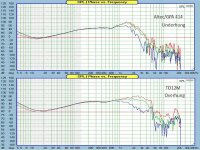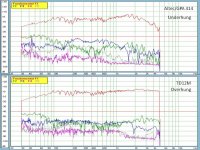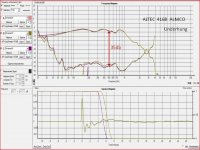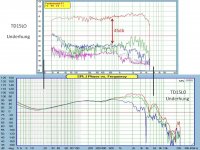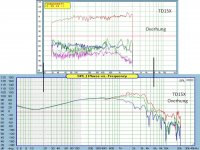This is very important, happens all the time - many times the sound will get "worse", because the system has become more resolving, when something is sorted out. Experience is part of the answer here, knowing that in fact that you're going in the right direction even though nominally the sound is harder to listen to ...Additionally, it is also possible to be mislead when improvement in one place more significantly reveal problems in others. This is why I started out with working on speakers and ended up going up the signal chain.
What is key, for me, is using "bad" recordings for testing, "good" recordings are hopeless for assessing changes, make it vastly harder to pick what's going on.
Frank,
I haven't razzed you for a long time now but I have to wonder how you make so many statements that you do when your reference is a set of cheap PC speakers. Yes I know that Brad Wood had something to do with them but I highly suspect that he would never call these any kind of reference or even a high quality speaker. Perhaps a bit better than other 60 cent speakers but nowhere near high enough resolution to make any real audio conclusion that I can take seriously. I have read some things you have said in other places and actually have been surprised by some of your reference materials you have sighted, but this droning on about the little things that never seem to have any substance is as pooge says getting monotonous.
I haven't razzed you for a long time now but I have to wonder how you make so many statements that you do when your reference is a set of cheap PC speakers. Yes I know that Brad Wood had something to do with them but I highly suspect that he would never call these any kind of reference or even a high quality speaker. Perhaps a bit better than other 60 cent speakers but nowhere near high enough resolution to make any real audio conclusion that I can take seriously. I have read some things you have said in other places and actually have been surprised by some of your reference materials you have sighted, but this droning on about the little things that never seem to have any substance is as pooge says getting monotonous.
soongsc,
Have you seen any overhung drivers that even come close to being linear? I don't think so and I would rather and do design with a lower efficiency underhung design that will always have a much higher linearity than any overhung design can ever achieve. Any overhung speaker by design is a nonlinear design, it is inherent in the design. The magnet lines of force are very different for the outer windings than the inner windings and I have seen no way to balance that with any field shaping techniques as Lynn has talked about.
Have you seen any overhung drivers that even come close to being linear? I don't think so and I would rather and do design with a lower efficiency underhung design that will always have a much higher linearity than any overhung design can ever achieve. Any overhung speaker by design is a nonlinear design, it is inherent in the design. The magnet lines of force are very different for the outer windings than the inner windings and I have seen no way to balance that with any field shaping techniques as Lynn has talked about.
I have never considered overhung, so I really don't know about them. Simply the mass of the coils make no sense to me. I am just wondering whether symmetric BL design of an under hung motor is desirable or not since it does not take much more manufacturing to accomplish it.
Last edited:
Fair enough comments, but remember this latest round started when Joshua asked why different metals on a power plug make a difference to the sound. Well, you can invoke pixie dust, or the magic of audiophile belief systems, but as an engineer I'd like an explanation that made sense being put into the arena. Especially since that's exactly what I've been playing with for a long time now ...Frank,
I haven't razzed you for a long time now but I have to wonder how you make so many statements that you do when your reference is a set of cheap PC speakers.
Sorry, the cheap speakers do have good resolution when everything is done right - I went to a hifi show recently, took some CDs with I know intimately, and the resolving power of the majority of expensive speakers, in the system context, was poor - when a third of the musical content disappears on a $100,000 speaker I tend to not be impressed ...
The "little things" do matter, I'm afraid - I want to listen to musicians playing, not a weak hifi system or a PA blasting away, and the tiny things are important for making that happen ...
Someone sent me a set of RCA connectors and said they were the most transparent he had ever used. Looked at the structure, it was a very simple straight through type design; did quick assessment on the material, basically pure copper including the coating. This just makes me think that most simple and straight forward is the way to go. You have other complicated plating for different reasons. But if the basics is compromised, we need to think whether we are complicating things for no total improvement.
When I get the new interconnects working, there will be a new connector match to go with it.
When I get the new interconnects working, there will be a new connector match to go with it.
I attached the common reference data for underhung/overhung speakers to help the discussion. I own Lambda drivers.
Attachments
LineSource,
You can't even compare one GPA driver to another from what I have seen in Lynn's comments. How are we to compare two completely different drivers like that? I would want to see two identical drivers with only the voicecoil and motor assembly changed. One problem with calling a driver underhung is that the amount of differential between the coil length and gap length has to be looked at. All underhung motor designs are not comparable.
You can't even compare one GPA driver to another from what I have seen in Lynn's comments. How are we to compare two completely different drivers like that? I would want to see two identical drivers with only the voicecoil and motor assembly changed. One problem with calling a driver underhung is that the amount of differential between the coil length and gap length has to be looked at. All underhung motor designs are not comparable.
This is the danger with any postThe circuit breakers should also be hardwired
This is a daft idea to hard wire the breaker.
This thread is running off the rails. It is about Ariel and its replacement. We need to get back to this.
Please Joshua you are really on the wrong thread. Start up your own thread about your subject You do not seem to be interested in building the Ariel replacement.
I was fortunate to hear the Ariels here in Perth about 14 yrs ago, when I was starting out building amps / horn speakers. They were driven by a SE 211 amp with Tango OTs and looked very beautiful, and had a sound that was a window into the whole SoundPractices world I aspired to. I had AudioNote Ks. But then when I heard Onkens with horns on top and I was blown away - this was it.
Now I am not so sure, maybe I got older, but I have the Onkens / horns in the house and I don't need 15" bass any more. (my son does). I feel to go beyond the Ariel maybe one could forgo the 15" drivers and an octave of bass, and build on the midrange strengths (and nice proportions) of the Ariel. It would be interesting to explore what small efficient drivers would more naturally mate with an upper mid horn / compression driver. And leave the low end to a sub if really wanted. Kind of on lines of what Gary is doing I guess. Purity, dynamics, imaging.
martin
Now I am not so sure, maybe I got older, but I have the Onkens / horns in the house and I don't need 15" bass any more. (my son does). I feel to go beyond the Ariel maybe one could forgo the 15" drivers and an octave of bass, and build on the midrange strengths (and nice proportions) of the Ariel. It would be interesting to explore what small efficient drivers would more naturally mate with an upper mid horn / compression driver. And leave the low end to a sub if really wanted. Kind of on lines of what Gary is doing I guess. Purity, dynamics, imaging.
martin
I was fortunate to hear the Ariels here in Perth about 14 yrs ago, when I was starting out building amps / horn speakers. They were driven by a SE 211 amp with Tango OTs and looked very beautiful, and had a sound that was a window into the whole SoundPractices world I aspired to. I had AudioNote Ks. But then when I heard Onkens with horns on top and I was blown away - this was it.
Now I am not so sure, maybe I got older, but I have the Onkens / horns in the house and I don't need 15" bass any more. (my son does). I feel to go beyond the Ariel maybe one could forgo the 15" drivers and an octave of bass, and build on the midrange strengths (and nice proportions) of the Ariel. It would be interesting to explore what small efficient drivers would more naturally mate with an upper mid horn / compression driver. And leave the low end to a sub if really wanted. Kind of on lines of what Gary is doing I guess. Purity, dynamics, imaging.
martin
If one can live without the lowest frequencies one can use horns like a labhorn or Carpenters folded basshorn. I think 20Hz sounds more like airconditioning tunnels in an office anyway. Thinking about building one tonight.
Last edited:
15" Midbass
I have been watching the sale of vintage speakers on Ebay over the last 5 years and have just focussed on Tannoy and Altec. It appears that the Tannoy Monitor Red/Gold 15" and the Altec Model 19 (15") are the versions with the highest resale values. Now my observations are not formal or independently verified but could indirectly mean that the 15" is the most preferred route for this type of speaker.
DonM
I was fortunate to hear the Ariels here in Perth about 14 yrs ago, when I was starting out building amps / horn speakers. They were driven by a SE 211 amp with Tango OTs and looked very beautiful, and had a sound that was a window into the whole SoundPractices world I aspired to. I had AudioNote Ks. But then when I heard Onkens with horns on top and I was blown away - this was it.
Now I am not so sure, maybe I got older, but I have the Onkens / horns in the house and I don't need 15" bass any more. (my son does). I feel to go beyond the Ariel maybe one could forgo the 15" drivers and an octave of bass, and build on the midrange strengths (and nice proportions) of the Ariel. It would be interesting to explore what small efficient drivers would more naturally mate with an upper mid horn / compression driver. And leave the low end to a sub if really wanted. Kind of on lines of what Gary is doing I guess. Purity, dynamics, imaging.
martin
I have been watching the sale of vintage speakers on Ebay over the last 5 years and have just focussed on Tannoy and Altec. It appears that the Tannoy Monitor Red/Gold 15" and the Altec Model 19 (15") are the versions with the highest resale values. Now my observations are not formal or independently verified but could indirectly mean that the 15" is the most preferred route for this type of speaker.
DonM
sound signature
Difficult question !
We have instruments to see 50 nuances of Grey to authenticate colors from a painting than eyes can't not see but we haven't with audio. Distorsion measure & polar response are not enough, a lot of studies show that even 15 distorsion row can affect the listener. We just play with 5 row in the better case (zaph and others). Sure it's better than yesterday, more scientific but not enough yet !
It's harder to know the difference between what two listeners hear (don't talk about cultural subjectivism and tastes) from a same system ! If we have two young people without any audio education, are we sure they hear the same thing if they are not identical twinns ? And with the older time after 30 to 40 years, I'm pretty sure than the equilibrium of a speakers is changed because the high frequency and the ratio between the low end and high end frquencies.
What is sure is playing with plugs and wires is in the bottom of the to do list for optimization. How much people buy expensive cancerigen rhodium plugs or wires when a simple better XO or simply speakers or amps will give far better results ?
It's like tweaking with cars, add stickers do not transform the car in Ferrari. Yes it's better in the eyes of the owner because its ears have the habits of small changes. Small changes exist but the summ is not equal to a big improvement in term of total quality : other speaker, other xo or design...
We must experiment, we must have more than one speaker at home to reset sometimes our ears. We must go at live acoustic events and try to buy good engeenering recording.
Difficult question !
We have instruments to see 50 nuances of Grey to authenticate colors from a painting than eyes can't not see but we haven't with audio. Distorsion measure & polar response are not enough, a lot of studies show that even 15 distorsion row can affect the listener. We just play with 5 row in the better case (zaph and others). Sure it's better than yesterday, more scientific but not enough yet !
It's harder to know the difference between what two listeners hear (don't talk about cultural subjectivism and tastes) from a same system ! If we have two young people without any audio education, are we sure they hear the same thing if they are not identical twinns ? And with the older time after 30 to 40 years, I'm pretty sure than the equilibrium of a speakers is changed because the high frequency and the ratio between the low end and high end frquencies.
What is sure is playing with plugs and wires is in the bottom of the to do list for optimization. How much people buy expensive cancerigen rhodium plugs or wires when a simple better XO or simply speakers or amps will give far better results ?
It's like tweaking with cars, add stickers do not transform the car in Ferrari. Yes it's better in the eyes of the owner because its ears have the habits of small changes. Small changes exist but the summ is not equal to a big improvement in term of total quality : other speaker, other xo or design...
We must experiment, we must have more than one speaker at home to reset sometimes our ears. We must go at live acoustic events and try to buy good engeenering recording.
Last edited:
When it comes to the goal of producing as close as possible a facsimilie of the real event I think one has to include the lowest lows and highest highs. While you might still have a thoroughly enjoyable system without that bottom octave or those barely perceptable upper harmonics it will still betray the experience of listening to a recording rather than being at the live event. Of course as this thread makes clear, there are a hundred and one details that go along with making a system that can transport you all the way. I would guess most people here have more than one system in more than one room. Personally I have 4 (and fortunately a wife who loves live music). While none is at the levels I fully aspire to each gives me alot of satisfaction (and some frustrations from time to time). Lynn has been very generous in sharing all he has learned and pointing out some great components and I'm sure when he get's his Beyond system together the original Ariels will still find a place in his home. So thank you Lynn for all the efforts put into this thread. I'm still learning and appreciating the joys of the journey. And if you haven't seen it here is something special that will all its imperfections speaks volumes of how music communicates the grandeur and tenderness of the soul Shy Boy and Girl Shock Simon Cowell on Britain's Got Talent (Jonathan and Charlotte) - YouTube
So then, Was Einstein wrong when he contradicted all current data and theory?
He didn't "contradict" any of it, he extended it. No theory that "contradicts" know facts is going to survive. Relativity did not "contradict" anything. It explained it in a way that allowed for a more detailed explanation of gravities effects.
Power-supply design is one of the big differences between the solid-state and vacuum-tube world. At a wild guess, maybe 10 to 20% of tube amps have correctly designed (non-ringing, non-overshoot) choke-fed supplies. The same kind of supply is super-rare in the transistor world, probably well under 0.1% of amps sold to audiophiles (never mind mass-market).
Unless you are sure the power supply is low emission, it's safe to assume to it's a big noisemaker, with very high current switching pulses at a 100 or 120 Hz rate. These pulses not only have near-squarewave risetimes, but glitches (holes) due to charge-storage effects in the silicon diodes. Soft-recovery or HEXFRED diodes get rid of the glitches, but do not get rid of of the switching current pulses. It takes an inductor that's rated for the (measured) peak currents of the PS circuit to do that, and inductors cost money and add size and weight to the chassis (they're typically as big as the power transformer itself). If it's a stereo amplifier, it's not good practice to share the inductor between channels (PS crosstalk), so you'll need two of them.
I've heard transistor amps that have well-designed full regulation for the entire amplifier, along with low switch-noise emission, and surprise, they sound like very good tube amps. Which tells us something about the other 99.9% of the amps out there, and why there's a big market for power cords and power conditioners.
Minor aside: the Karna sounds worse with audiophile power cords, and really bad with audiophile power conditioners. It thrives on heavy-duty 12-gauge cords for industrial applications, and being plugged directly into the power outlet.
Kinky geek-note: I've seriously considered getting a motor-generator set to place in the garage, so I have nice clean 60 Hz 120V power with pretty sine waves for the audio system. The sine waves that come off the power line have some nasty flat-topping and other glitches, thanks to other houses in the neighborhood with all those switchmode power supplies for TVs and computers.
Unless you are sure the power supply is low emission, it's safe to assume to it's a big noisemaker, with very high current switching pulses at a 100 or 120 Hz rate. These pulses not only have near-squarewave risetimes, but glitches (holes) due to charge-storage effects in the silicon diodes. Soft-recovery or HEXFRED diodes get rid of the glitches, but do not get rid of of the switching current pulses. It takes an inductor that's rated for the (measured) peak currents of the PS circuit to do that, and inductors cost money and add size and weight to the chassis (they're typically as big as the power transformer itself). If it's a stereo amplifier, it's not good practice to share the inductor between channels (PS crosstalk), so you'll need two of them.
I've heard transistor amps that have well-designed full regulation for the entire amplifier, along with low switch-noise emission, and surprise, they sound like very good tube amps. Which tells us something about the other 99.9% of the amps out there, and why there's a big market for power cords and power conditioners.
Minor aside: the Karna sounds worse with audiophile power cords, and really bad with audiophile power conditioners. It thrives on heavy-duty 12-gauge cords for industrial applications, and being plugged directly into the power outlet.
Kinky geek-note: I've seriously considered getting a motor-generator set to place in the garage, so I have nice clean 60 Hz 120V power with pretty sine waves for the audio system. The sine waves that come off the power line have some nasty flat-topping and other glitches, thanks to other houses in the neighborhood with all those switchmode power supplies for TVs and computers.
Last edited:
Power-supply design is one of the big differences between the solid-state and vacuum-tube world. At a wild guess, maybe 10 to 20% of tube amps have correctly designed (non-ringing, non-overshoot) choke-fed supplies. The same kind of supply is super-rare in the transistor world, probably well under 0.1% of amps sold to audiophiles (never mind mass-market).
Unless you are sure the power supply is low emission, it's safe to assume to it's a big noisemaker, with very high current switching pulses at a 100 or 120 Hz rate. These pulses not only have near-squarewave risetimes, but glitches (holes) due to charge-storage effects in the silicon diodes. Soft-recovery or HEXFRED diodes get rid of the glitches, but do not get rid of of the switching current pulses. It takes an inductor that's rated for the (measured) peak currents of the PS circuit to do that, and inductors cost money and add size and weight to the chassis (they're typically as big as the power transformer itself). If it's a stereo amplifier, it's not good practice to share the inductor between channels (PS crosstalk), so you'll need two of them.
I've heard transistor amps that have well-designed full regulation for the entire amplifier, along with low switch-noise emission, and surprise, they sound like very good tube amps. Which tells us something about the other 99.9% of the amps out there, and why there's a big market for power cords and power conditioners.
It's not just a big inductor that's needed for SS amps. It has to be designed correctly with a proper air gap in the core for the large current swings that you don't find in high voltage tube circuitry with much smaller input caps in the PS. It's not even easy to find good design criteria for these. However, it would be nice to find some good design criteria, and someone or some place to find such inductors with proper build.
It's not just a big inductor that's needed for SS amps. It has to be designed correctly with a proper air gap in the core for the large current swings that you don't find in high voltage tube circuitry with much smaller input caps in the PS. It's not even easy to find good design criteria for these. However, it would be nice to find some good design criteria, and someone or some place to find such inductors with proper build.
I agree. The correct approach for a solid-state power amplifier is a repeated process of trying several custom-made choke-feed inductors (with air gaps) scaled to the size of the cap bank and peak-current capabilities of the emitter-follower stage.
The steady current demand of Class A operation would greatly simplify the choke-fed supply design, at the expense of power. Then again, big heat sinks and whisper fans aren't that expensive. This would be a fun project for the solid-state crowd, but not something I'm interested in.
Right now, I'm staying tuned to Gary Dahl's experiments with a dual-woofer system.
Last edited:
- Home
- Loudspeakers
- Multi-Way
- Beyond the Ariel
